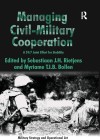Managing Civil-Military Cooperation
Written by: Sebastiaan J H Rietjens and Myriame T I B Bollen (eds),
Ashgate Publishing Limited, Surrey, 2008,
ISBN: 9781315593470, 280pp
Reviewed: by Major Richard Peace
Civil-military cooperation is now a feature of nearly all Australian current operational deployments. While seen by some as a black art, this book attempts to dispel some of the misconceptions that arise on what is civil- military cooperation. This book is a collection of essays based on the Dutch military experiences in civil-military cooperation across a variety of conflicts over the last decade. The book aims to provide a platform for sharing knowledge, experience, research and know-how between military and civilian actors, scientists, consultants, humanitarians, representatives of afflicted people, and policy-makers. In order to achieve this goal the authors, from either a practical or research background, share insights and findings concerning civil-military cooperation during peace missions to promote stabilisation, reconstruction, humanitarian assistance and endurable peace.
The book is structured into four parts, with several essays in each part. Part 1 provides an introduction and external orientation into what is civil-military cooperation. This section provides an interesting discourse on counterinsurgency operations contrasting the Dutch, German and French experiences against the British experiences post Second World War. Other essays examine the approaches to civil-military cooperation from the military and civilian viewpoints, highlighting the different aims and approaches adopted. Part 2 focuses on aspects during the conduct of Humanitarian Operations. The main point made in the various essays in this section is how the military can have an immediate impact at the time of initial disaster, but over time their effectiveness reduces due to an inability to restructure to meet the changing needs of the civilian population. Additionally, in areas of conflict, warring parties are suspicious of any external military forces providing humanitarian aid and can actively work against the provision of aid. Part 3 examines the function of civil-military cooperation during stabilisation and reconstruction operations.
With several examples from Iraq and Afghanistan, the key points raised on why missions fail are due to lack of an overall strategy, a lack of funding, and application of Western standards. Part 4 attempts to introduce measure of performance, with a very good example provided of how to gauge the effectiveness of military actions from a civil viewpoint.
Overall, the book was an easy read with terminology that most military readers would understand (good use of NATO terminology). It was interesting to note the Dutch viewpoint is very similar to the Australian approach, which highlights the interaction occurring in Afghanistan at the moment. The editors have attempted to provide the uninformed reader with sufficient information to enable an understanding of civil-military cooperation. The overall theme is that effective civil-military cooperation requires training and understanding. The book is recommended either for those personnel looking to deploy into a reconstruction or humanitarian aid environment and for those personnel who have previous exposure to civil-military interaction and wish to increase their knowledge.

